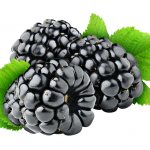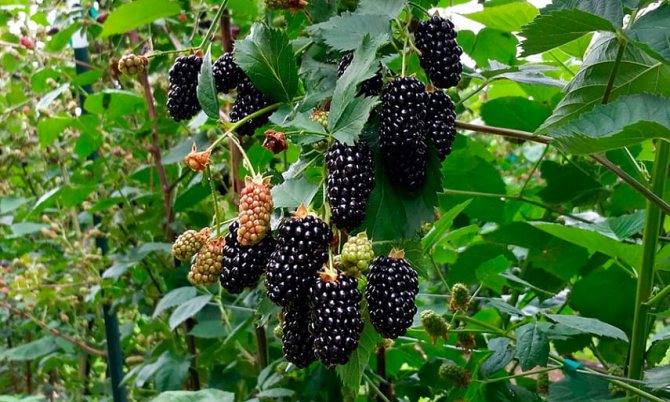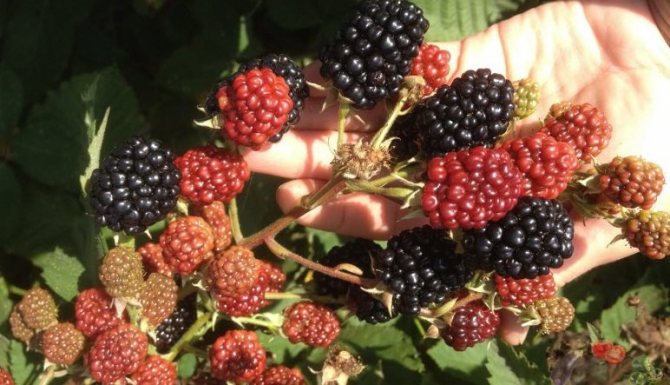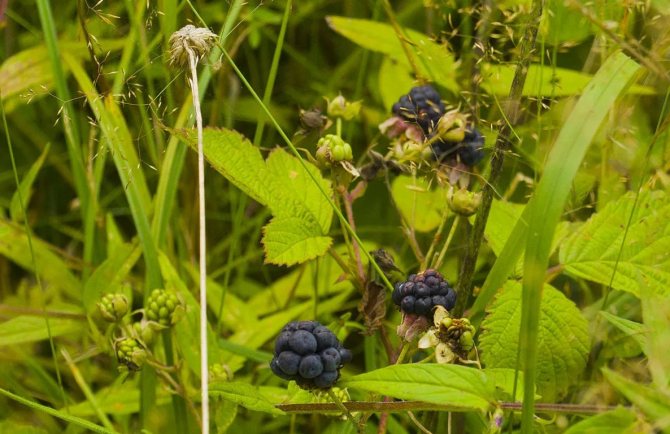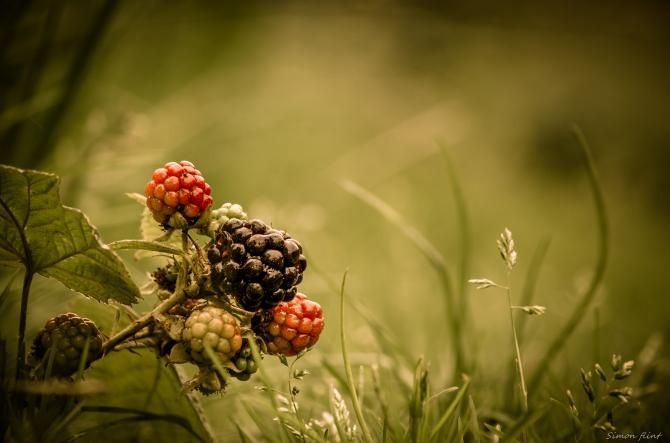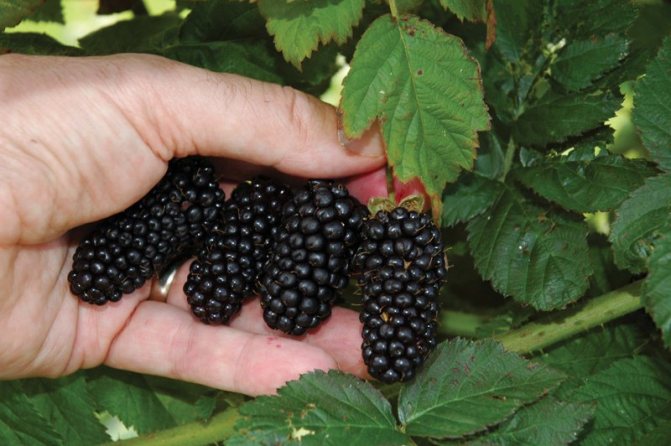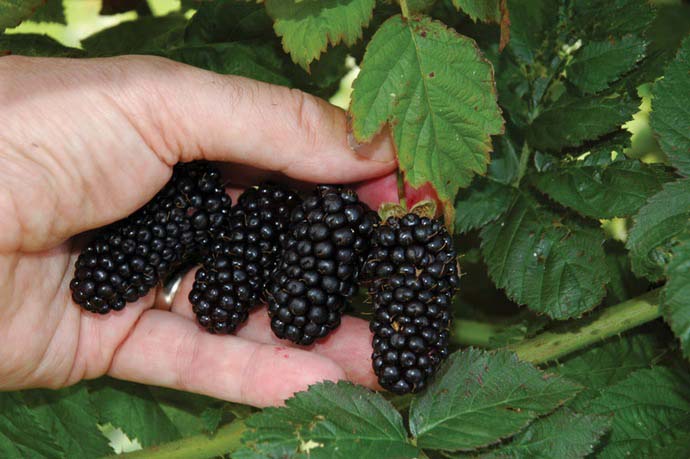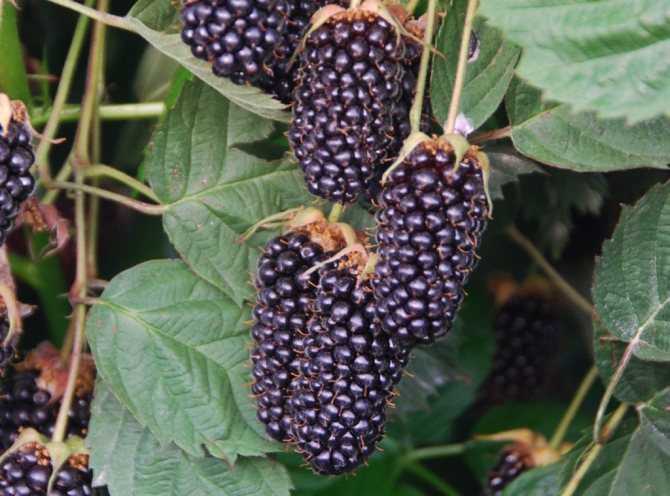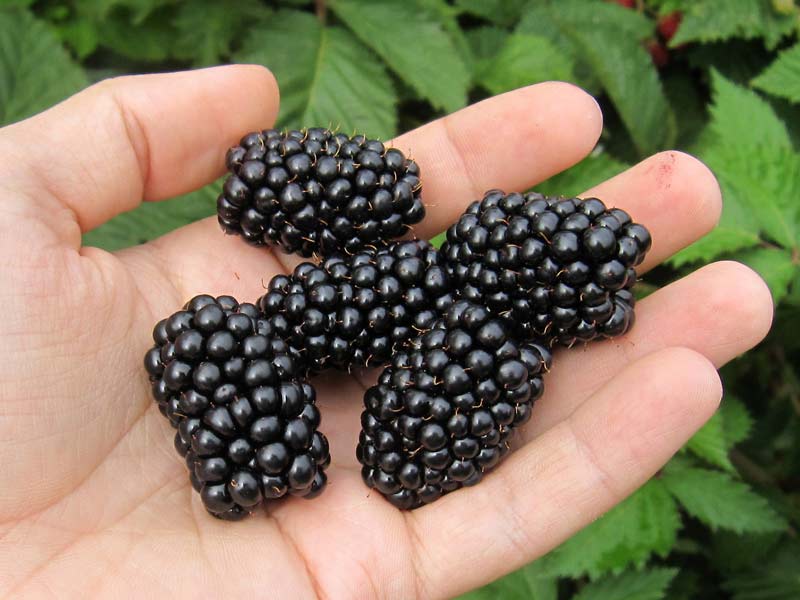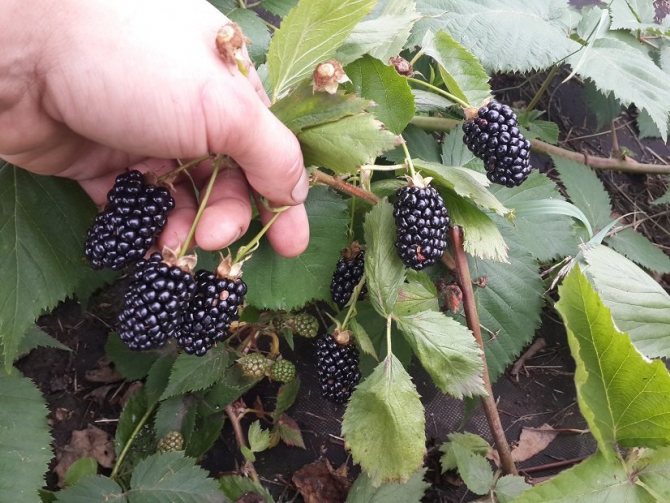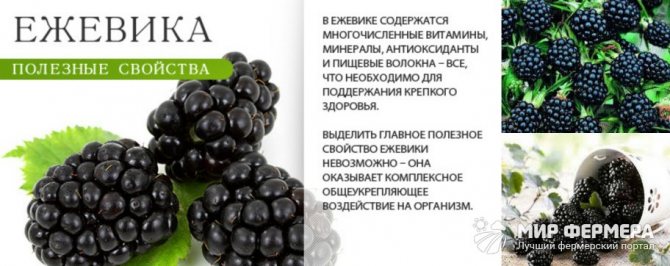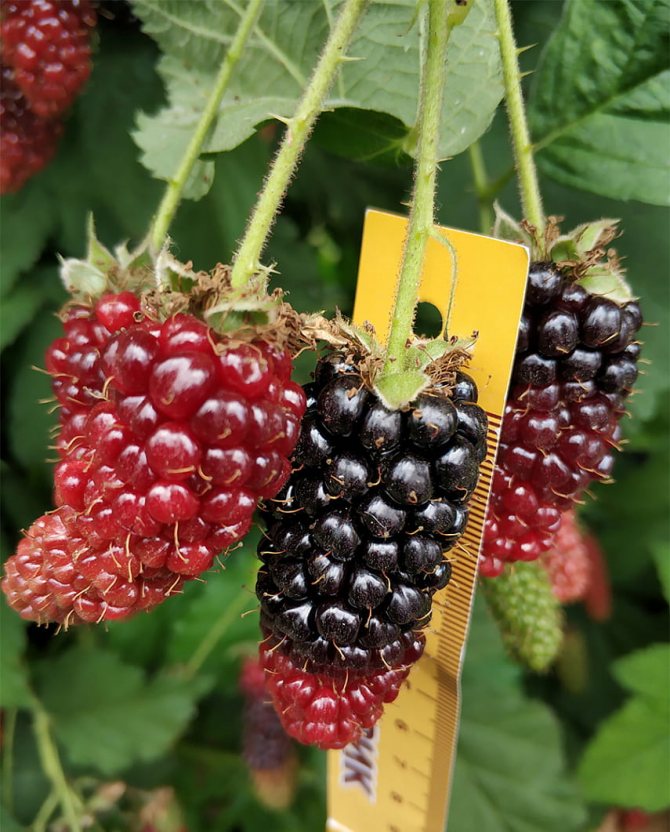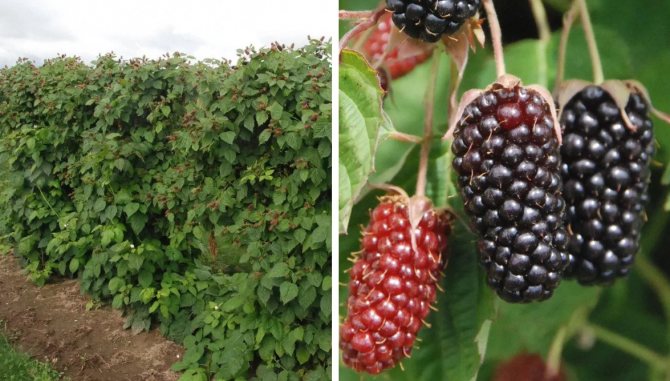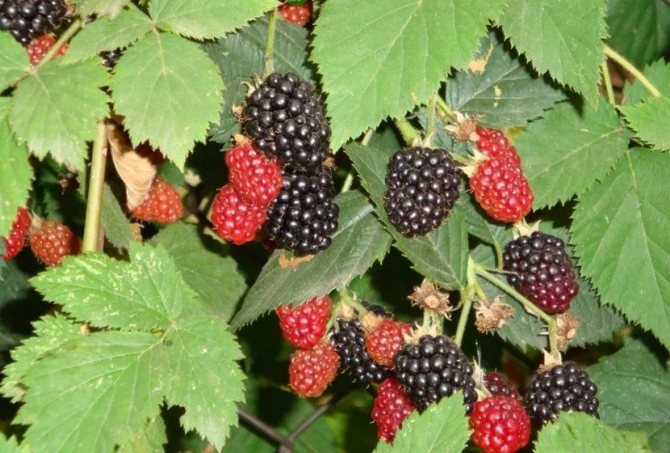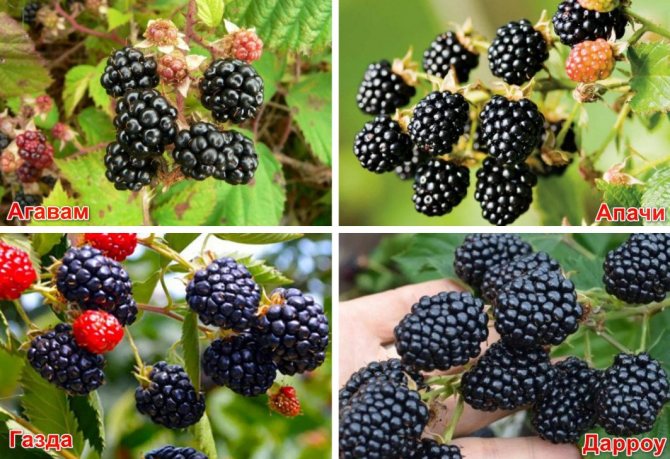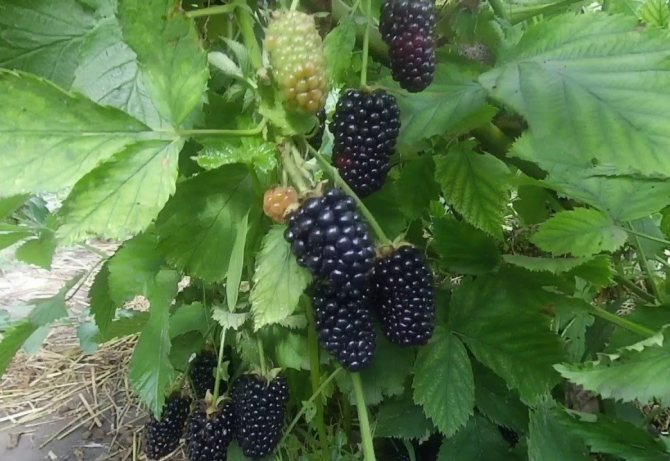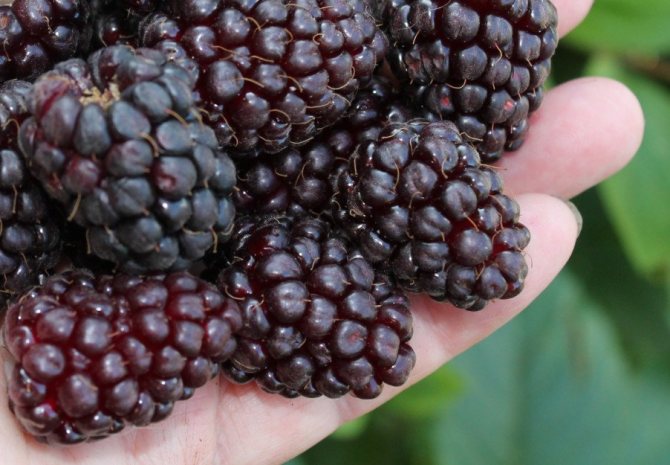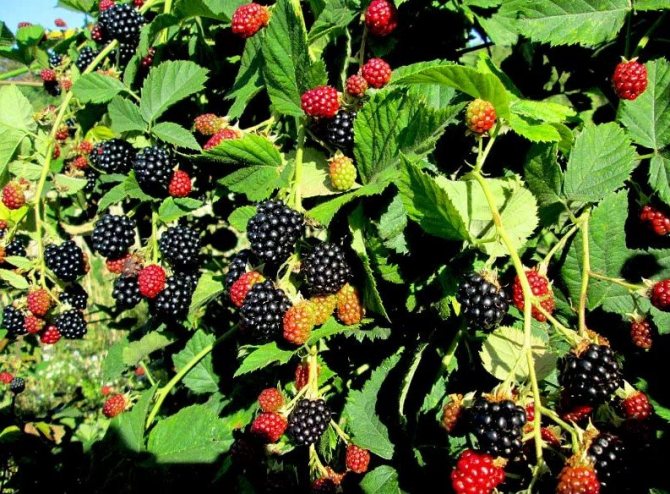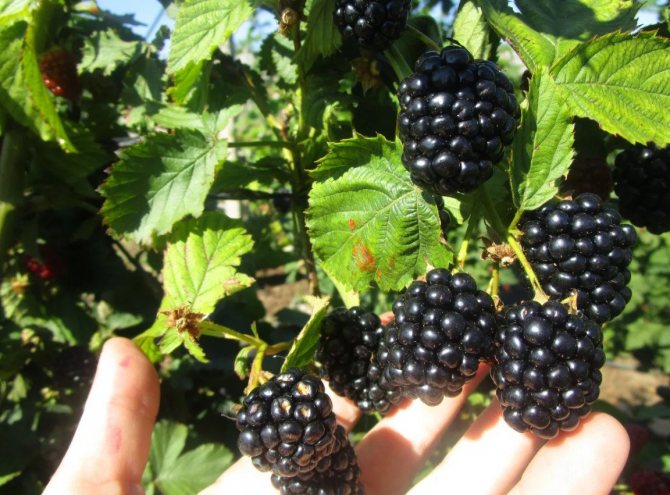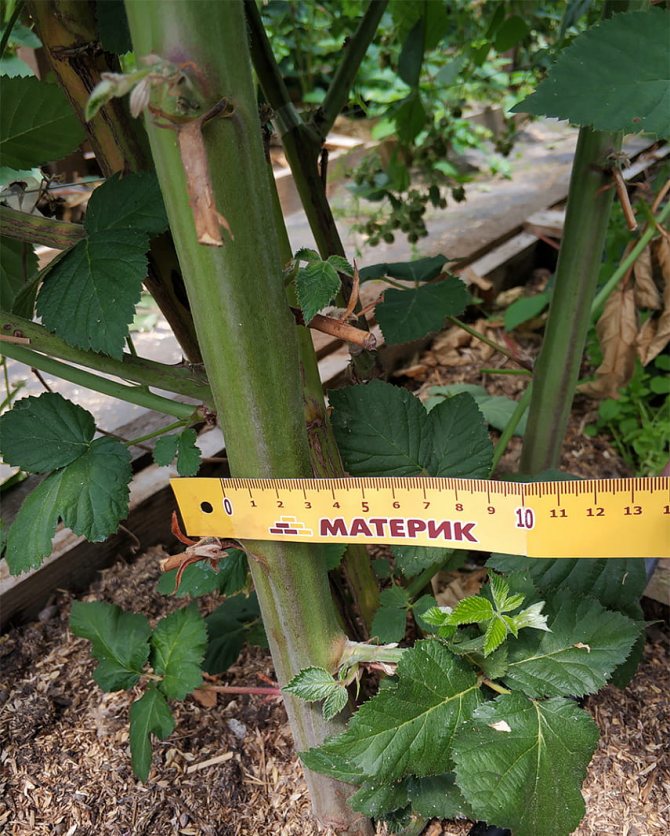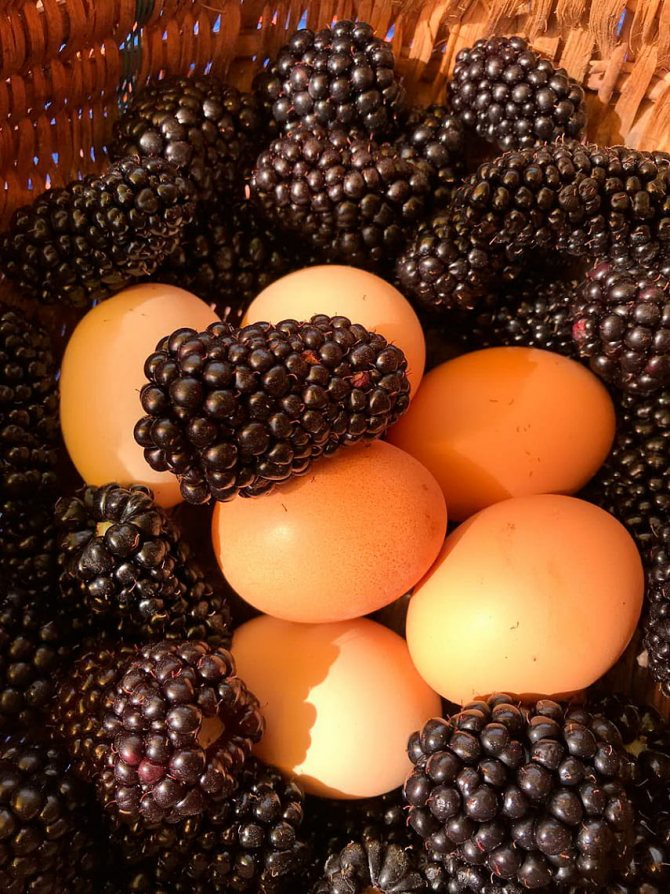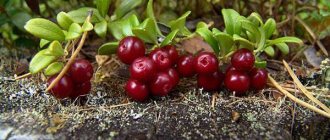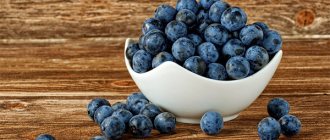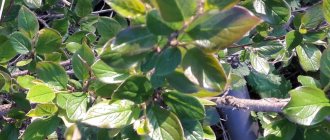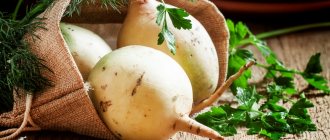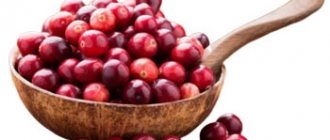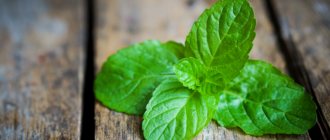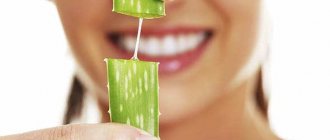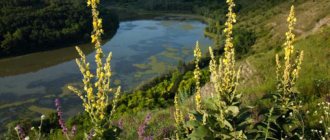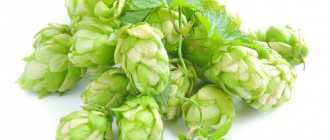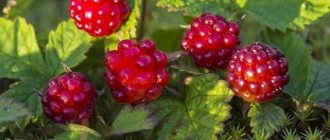Blackberry is a subgenus of plants of the genus Rubus, of the Pink family. On the territory of Russia, two varieties of this plant grow: bushy blackberries and gray blackberries. It can grow in forests and can be found in various regions: from the Arkhangelsk region to the Caucasus.
Blackberry is a berry that looks and tastes amazing.
Another type of plant - garden blackberry, is planted in the conditions of personal plots. Blackberry as a berry seems not very attractive to many, because it is very inconvenient to collect - wild blackberry thorns complicate the process. But modern breeders have long been able to cope with this problem. As a result, a lot of blackberry varieties were bred: agave, arapaho, himalaya, thornless, darts, thornfri, triple, etc., which are shrubs without thorns with large fruits, which are a pleasure to collect.
What is blackberry and what does it look like
Wild blackberry belongs to the Rosaceae family, native to the North American continent, Eurasia. How does blackberry grow? It is found on forest edges or open areas, in mixed and coniferous forests, in river floodplains and ravines, in clearings and in the forest-steppe zone.
Where does blackberry grow in Russia? The habitat of the plant is from the northern regions to the southern regions. In the foothill areas, often impassable thickets of blackberry bushes grow.
The culture is a thorny bush, the height of which ranges from 1 to 3 m. The plant is beautiful at any time of the year: in spring - rich green foliage, in summer - pinkish flowers, in autumn - dark brown or black berries. The fruit is characterized by a fragrant smell, sourish, pleasant, slightly astringent taste.
A useful plant blooms at the beginning of the summer season, and usually pleases with a harvest in August - an abundance of small berries. Allocate up to 200 varieties of blackberries. Suitable for growing in the country:
- Black satin;
- Texas;
- Medana;
- Chokeberry;
- Agave.
Botanical description
Blackberry gray or ozhina - Rubus caesius L. - semi-shrub up to 1.5 m high with creeping or erect shoots.
The plant has perennial, powerful, creeping rhizomes that go deep into the soil, which can explain its drought resistance.
Aerial shoots of two types: annual vegetative and biennial generative, dying off after the second year of life. Annual curved shoots take root when in contact with the soil. The trunks of biennial shoots are gray-gray, erect, with sharp small thorns.
The leaves are ovate, large, the upper ones are trifoliate, the lower ones are five-leafed. Often their petioles are also covered with small needles.
The flowers are white or pale pink, regular, large - up to 3 cm in diameter. Collected in apical corymbose inflorescences, equipped with long pedicels. Sepals in the amount of 5 free. There are a lot of pistils and stamens, nectar and pollen, so insects pay their closest attention to them, pollinating the plant, and at the same time ensuring productivity.
Blackberries, like raspberries, are a complex drupe. It is firmly connected to each other by a soft white fruit stem. Fruits are round and cone-shaped in various colors: from black to red, purple, purple, yellow and white (depending on the variety).
The shrub blooms from May to September.The berries ripen about a month after flowering. During the fruiting period, on one bush, you can simultaneously find both flowers and fruits (both green and ripe). The fruiting of the blackberry plant is quite abundant annually. Characteristics of the most popular large-fruited varieties:
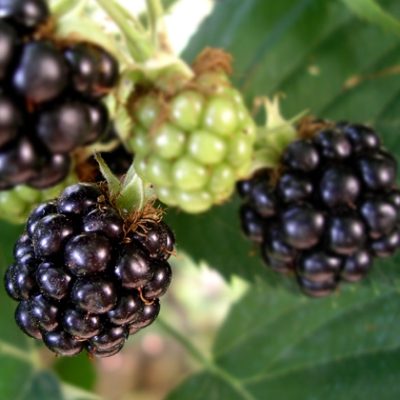
- Eldorado is a bush with strong, sturdy, erect stems and drooping tops. The thorns are curved, large, located along the entire length of the shoots. Fruits about 3 g. Berries are black, sweet-sour, with a specific aroma;
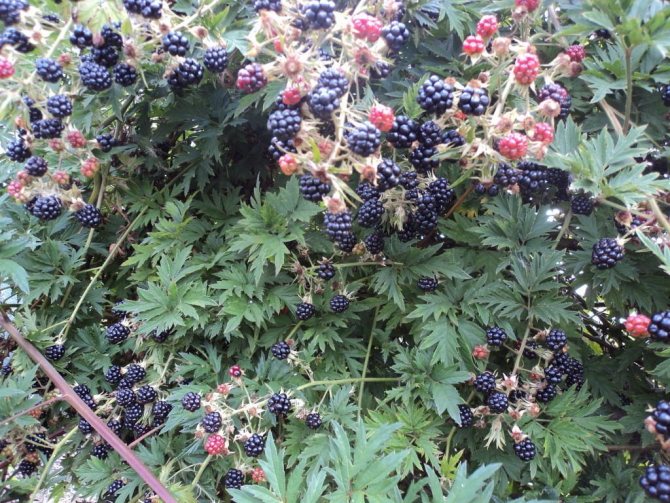

- Oregon is an evergreen shrub with creeping, powerful, thornless shoots. The berry is very sweet, weighing up to 8 grams, round or elongated, black. An early variety with a very high yield;
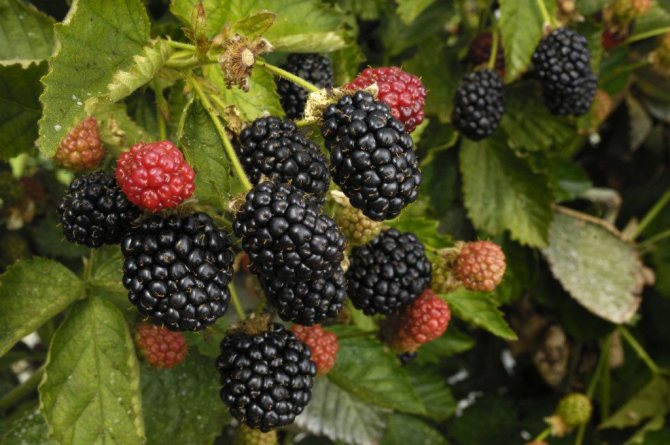

- Tornofree is one of the first thornless shrubs that bloom profusely with white and pink flowers. Forms long, hard, semi-spreading shoots. High-yielding and unpretentious. Berries are dark purple, sometimes black, shiny, tight, weighing about 6 grams;
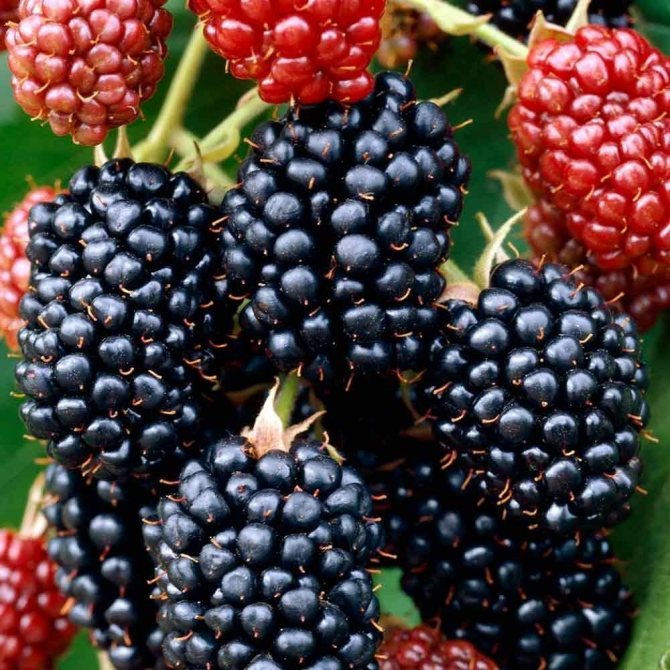

- Darrow is one of the frost-resistant upright varieties. Berries are black sweet and sour, weighing no more than 4 grams. They are grown mainly on supports so as not to damage the shoots under the weight of the berries;
- Eri is a straight-growing shrub, the shoots of which reach up to 2.5 meters in height. It blooms profusely with large white flowers. Berries are large, black and purple. The taste is sweet with a slight sourness and delicate aroma.
Planting and leaving
The plant is planted in the spring, when the soil is already well warmed up, or in the fall before the onset of frost. Landing is carried out in a well-lit place protected from the wind. If the soil is fertilized, then you do not need to specially fertilize, otherwise the bush, to the detriment of fruiting, will begin to rapidly grow greenery. Mineral and organic fertilizers are applied to the depleted soil before planting.
Upright varieties are planted at a distance of 1 m, creeping ones - at 1.5 m.
Caring for garden blackberries is not difficult and consists in regular loosening of the soil, watering, weeding. Planted seedlings are watered regularly during the first month, as well as in dry weather. Fruiting - during the period of intensive growth and ripening of berries.
Properties and calorie content of fruits
Culture is valued for its useful chemical composition:
- vitamins in blackberries: K, P, E, C, A, PP;
- micro and macro elements;
- phenols;
- pectin;
- organic acids;
- fructose;
- fiber;
- tannins;
- glycosides.
Blackberries are especially in demand in the diet, the calorie content of fresh berries is low. For 100 grams of product, the calorie content is 43 kcal. BJU blackberry - 1: 0.3: 13, where:
- proteins - 7%;
- carbohydrates - 88%;
- fats - 5%.
In frozen blackberries, the calorie content increases and is equal to 64 kcal, 92 kcal - in canned berries. The fruits are rich in composition, they must be included in the menu:
- phosphorus forms tooth enamel, normalizes energy metabolism, controls acid-base balance, reduces pain in arthritis;
- copper takes part in hematopoiesis, protein synthesis;
- magnesium is responsible for metabolism, protects against osteoporosis;
- calcium refers to building materials for bones and teeth;
- zinc enhances male and female libido, has a beneficial effect on immunity;
- potassium stabilizes the digestive tract, accepts nerve impulses;
- cobalt affects hematopoiesis, liver and central nervous system functions, it is recommended when working with an increased background of radiation.
- sodium delivers carbon dioxide, affects protein metabolism;
- molybdenum resists sexual dysfunction, caries, protects against gout. Its lack is the reason for the formation of kidney stones, and the risk of developing cancer increases.
Reproduction
Gardeners propagate the blackberry culture by means of seeds, they are sown before winter on permanent places of growth in a depth of five cm. And also by the vegetative method. The main options for propagating a blackberry culture prone to lining are:
- Disembarkation by layering from the tops.
- Reproduction by root shoots.
- Cuttings of blackberry rhizomes.
- Propagation by cuttings of a bush.
- By dividing the bush.
Varietal varieties of blackberry crops that grow straight are propagated in the same way, except for the option with layering from the tops.
Useful properties and benefits of blackberries for the human body
Consumers are wondering what blackberries are good for. They refer to the healing properties of blackberries:
- Confronting free radicals.
- Moisturizing the epidermis.
- Saturation, elimination of hunger.
- Supporting brain performance.
- Enhancing immunity, regulating blood sugar levels and reducing the incidence of epileptic seizures.
- Bone strength.
- Anticarcinogenic and antibacterial qualities.
- Prevention of arterial blockage, ensuring normal blood flow.
Blackberry Karaka Black
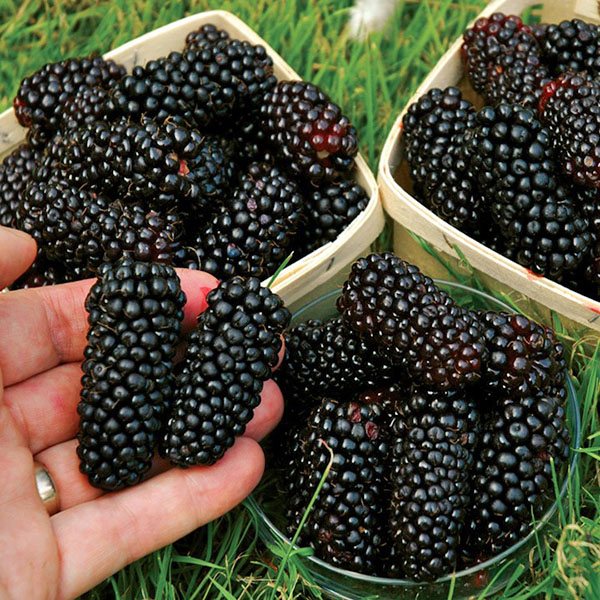

Studying the descriptions and photos of blackberry varieties, you can not only appreciate the merits and weaknesses of the culture, but also make amazing discoveries. For example, the new blackberry Karaka Black is a native of New Zealand, and in the genus the plant has not only its closest relatives, but also hybrids obtained from crossing blackberries with raspberries.
This technique of scientists makes it possible to achieve the largest possible berries, enhance their delicate aroma and make the fruits more suitable for transportation. The mass of the elongated, tasty berry of the blackberry variety shown in the photo is about 10 grams. The skin is dense, glossy black. The pulp is juicy and tasty.
Due to the gradual ripening, a consistently high yield is harvested for 1.5–2 months.
Blackberry leaves medicinal properties and contraindications
Both berries and blackberry leaves are noted for beneficial properties. Raw materials are used to prepare decoctions, infusions. Medicinal properties are manifested in the treatment:
- Oral cavities - the tincture on blackberry leaves has an antibacterial effect.
- Diarrhea - will solve the problem, the beneficial properties of herbal medicine - relieve indigestion.
- Ulcers - a blackberry extract with an antibacterial effect does a good job.
- Hemorrhoids - Blackberry lotions soothe the manifestations of the disease.
- Hearts - flavonoids in a healthy blackberry infusion cope with dysfunctions of blood vessels and heart, have a positive effect on well-being.
- Dermatitis, osteochondrosis, joint diseases.
- Dropsy - the broth frees the body from the accumulated fluid.
- Abscesses, bruises - crushed leaves are applied to the wounds.
Benefit for health
The beneficial qualities of blackberries have been known since ancient times., even Hippocrates himself used it for medicinal purposes.
It has long been believed that with the help of this berry you can get rid of gout, arthrosis, remove warts and strengthen the gums.
It contains fructose, ascorbic acid, glucose, carotene, malic, tartaric, citric, nicotinic, salicylic acids, tocopherol, B vitamins.
Blackberries are rich in iron and potassium, which give them their characteristic color.... Besides them, there is copper, phosphorus, magnesium, manganese.
The berry helps a person with various diseases, including cardiovascular.
It allows strengthen the heart muscle, lower blood pressure, cleanse blood vessels, has a beneficial effect on the genitourinary system, kidneys.
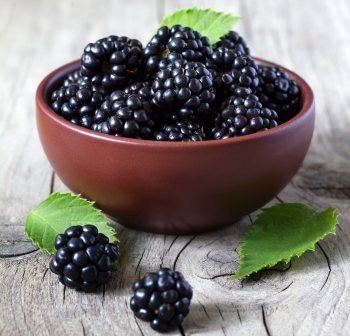

The berry has a beneficial effect on people suffering from cholecystitis: it has a choleretic effect, prevents inflammation, congestion, stones.
The antioxidant properties of blackberries help the body fight aging and cancer.
For the treatment of colds, tea with fruits is brewed, because they are considered natural aspirin - they relieve inflammation, lower the temperature.
They eat sweet and sour black berries and leaves of the plant, which contain twenty percent tannins. They are brewed and used for dysentery, diarrhea, pulmonary and stomach bleeding.
Blackberry juice, which is obtained from juicy shoots, leaves and berries, helps with bronchitis, sore throat, tracheitis, pharyngitis.
It is effective for fever, anemia, intestinal disorders. A decoction of the leaves is used in the treatment of gingivitis, stomatitis: rinse the mouth with infusion.
Blackberry has a beneficial effect on the brain, strengthens memory, speeds up thought processes. It is used in a state of neurosis or stress, it reduces the degree of agitation, allows you to sleep peacefully.
The leaves of the plant are an excellent remedy for healing wounds. They are used in the treatment of lichen, eczema, ulcers and abscesses.
A poultice of crushed leaves is applied to the affected skin... Poultices also stop bleeding.
A decoction of the leaves is used as an antihelminthic agent for pets, at least once a week. It will not be difficult for a pet to drink infusion: it will perfectly drink liquid instead of water.
Do you know how kumis is useful for men and women? We will help you! You will find the answer to the question in our article.
This publication will tell you about the dangers and health benefits of boiled beets.
And you can learn about the beneficial properties of rabbit meat from another review article.
Blackberries in medicine
Berries are used in medicine: they strengthen the body due to the rich content of useful minerals and vitamins. Blackberry leaves are used to prepare medicinal broths. They are used for lotions in the treatment of ulcers, like diuretics. The use of fresh leaves is to tighten the affected areas of the epidermis.
With diabetes mellitus
Diabetics can eat raw berries, as well as prepare juices and desserts. A useful product that is quickly absorbed, it is distinguished by a small amount of calories, a low GI. Blackberries do not cause obesity in diabetics. Vegetable sugar berries do not overload the pancreas, stabilize the level of glucose in the blood and urine.
With pancreatitis
Berries are eaten in moderation, only in the period of remission. If the disease worsens, blackberries are prohibited.
With gastritis
Special useful tinctures are prepared. The menu includes fresh berries, blackberry juice.
With gout
It is advisable to limit blackberries, rich in oxalates and fructose, in order not to complicate the disease. The benefits of antioxidants in fruits are protection against gouty attacks, reducing the amount of uric acid. The state of health determines the consumption of blackberries for gout.
Blackberry culture in the autumn
Crop care work in the fall includes preparing the plants for wintering. Initially, we carry out the trimming. Next, we mulch the soil around the circumference of the root system with dry sawdust or peat composition. We spray vegetation with copper sulfate in order to prevent diseases and harmful insects.
In the event that winter temperature conditions are less than -10 oC, the bushes need to be wrapped. Frost-resistant varietal species tolerate such regimes normally, they should be wary of frosty days below -20 oC. There are several variations of cover. You can, for example, cut off the plant and remove the branches from the supports. Place them on the ground, cover them with corn leaves, and lay on top of it a cloth intended for covering or polyethylene film. Carefully lay out the shoots of upright varietal species on the soil without breaking them. To do this, it is recommended to attach a load to the tops of the processes in advance from the last days of summer. He will gradually bend the branches to the ground. Blackberry culture does not vomit under cover.
This means that it is successful to use humus composition, hay, straw or sawdust as insulation. And fallen leaves are not suitable for these purposes, because of the risk of preserving microorganisms dangerous for blackberry vegetation on it. The blackberry leaf that fell off in the fall must be collected and burned.
Blackberries in cosmetology
The beneficial ingredients of the product help in nourishing body treatments. The formulation is based on the bactericidal properties of the plant.Broths are used for acne (lotion), dandruff (rinse), dermatological diseases (hand baths). To preserve the beauty and health of the skin of the face, just right for useful masks:
- Anti-inflammatory. Pour over chopped blackberry leaves, put in cheesecloth, place on face for 20 minutes. Do not rinse off after the session.
- Refreshing. Mash the blackberry berry until puree. Take in equal proportions - 2 tbsp. l. - a mixture of berries and cream, mix, apply on the skin for 15 minutes.
- Anti-aging. Squeeze juice from mashed berries. You will need 100 ml of the product, 50 g of sour cream, which is mixed and applied to the face, décolleté, neck for half an hour. Benefits for the body - the return of youthful skin.
Blackberries as a natural dye
More preferable than artificial analogs: the berry will not harm the hair, it is responsible for the natural shade and shine. It dyes strands and strengthens at the same time. Girls use a recipe for applying healthy vegetable juice to dry curls. Wash your hair after an hour. After manipulation, the hair acquires a brown-red color, a healthy look.
To avoid undesirable consequences, it is undesirable for blondes to use a berry remedy for dyeing curls.
Harmful insects and diseases
Diseases and harmful insects in blackberry and raspberry crops are the same. Blackberry culture in gardens is susceptible to rust, powdery mildew, anthracnose, white spot, purple spot, gray mold. Also, the culture may suffer from a lack or from an excess of trace elements in the soil and due to violation of the laws of agricultural technology.
Why do blackberries turn yellow? Most likely, this comes from a lack or an overabundance of trace elements. You should evaluate the volume and quality of added dressings and find your oversight.
Harmful insects can wreak havoc on crops. These are mites, raspberry kidney moth, raspberry-strawberry weevil, raspberry beetle, nutcracker, and also aphids, gall midges and caterpillars of butterflies - moths, raspberry glass cases. In the fight against such harmful insects, the process of spraying plants with karbofos gives positive results. If we make it a rule to carry out the treatment of the culture in order to prevent such drugs in the spring, ahead of bud break, and in the fall, after harvesting, we can protect the plants from insect attacks.
How to care for blackberries - on video:
Why are blackberry leaves useful?
The green mass of a useful plant is valued no less than a berry. The biochemical composition of foliage is what blackberries are useful for in the treatment of various pathologies. The green leaf is characterized by a complex action:
- antioxidant;
- disinfecting;
- fastening;
- restoring;
- antibacterial;
- diuretic;
- invigorating;
- diaphoretic;
- helping to heal wounds;
- sedative.
The healing properties and benefits of blackberry leaves are found when applied externally. Young leaves are harvested in the spring.
Blackberry Reuben
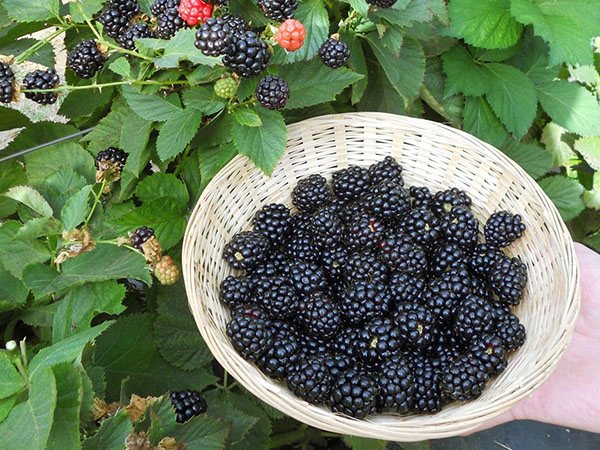

The hybrid blackberry Ruben bears fruit on the shoots of both the first and second year of life. The first harvest is in July, then very large berries weighing from 10 to 16 grams ripen at the end of summer and are harvested until October. The repaired blackberry is distinguished not only by double harvesting of berries, but also by its high yield.
Powerful bushes are erect, do without support and tolerate frost well.
How to choose and store blackberries
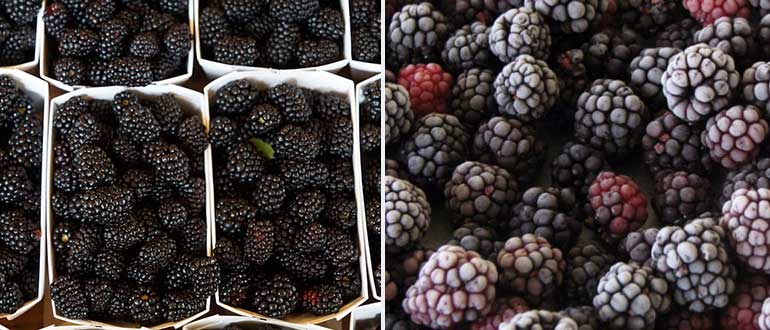

When buying healthy berries, choose dark fruits that are soft to the touch. In immature, hardy specimens - pink or reddish color. When choosing a product, berries are preferable:
- with a rich shade;
- dry, not sticking to each other;
- free of mold, foreign inclusions.
Berries spoil quickly, they are stored for a maximum of 3-4 days.
The berries are kept in a container. Freezing will lengthen the harvest season.In winter, you can prepare healthy juices, compotes or desserts from blackberries, which in the diet have a positive effect on the health of the body.
Blackberry culture and its varieties
- Blackberry bushy culture, it is also kumanika, it is also dense blackberry. It is distinguished by flexible stems with spines that grow in a reclining state. Its fruits have a blue-violet hue.
- Blackberry culture is gray. A bushy plant with upright processes. A whitish coating appears on them, and there are thin medium-sized thorns. Fruits of a charcoal shade of small dimension, they have a gray dusting, outwardly similar to the fruits of raspberries. Fruits ripen in August.
What can you cook blackberry recipes
Among users, drinks, homemade blackberry rolls are in demand, which will benefit.
Smoothie
Components:
- banana - 1 pc.;
- blackberries - 1 tbsp.;
- milk - 1 l;
- granulated sugar - 0.5 tbsp.
Cooking technology:
- Cut the peeled banana into pieces.
- Place the fruit mixture in a blender.
- Add sugar, pour in chilled milk, beat for 3 minutes.
- Pour the resulting composition into glasses.
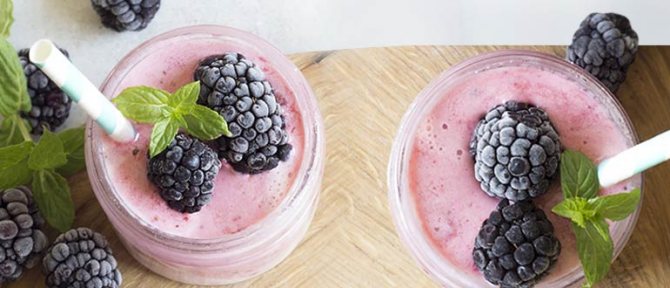

Jam
Components:
- sugar - 1 kg;
- blackberries - 1 kg.
Cooking technology:
- Sort out, rinse the berries, place in a wide basin.
- Cover with granulated sugar.
- Leave for 3-4 hours until juice appears.
- Put it on the stove.
- Bring to a boil, stirring constantly.
- Remove from heat for 6-8 hours.
- Boil again.
- Cook for 10 minutes.
- Put in jars, roll up.
Pouring
Components:
- sugar - 1 kg;
- berries - 3 kg;
- vodka - 300 ml.
Cooking technology:
- Rinse and dry the sorted berries.
- Place in a 3 liter jar in layers, sprinkling with granulated sugar.
- Shake a couple of times, put a rubber glove on your throat, making a hole with a needle.
- Put on the windowsill.
- Filling the glove with gas signals the fermentation of the product, which takes from 3 weeks to 1 month. It is determined by the temperature regime, illumination.
- After fermentation, the composition is filtered through cheesecloth.
- To consolidate the result, pour in vodka.
- The filling is made into bottles, hermetically sealed.
Planting a blackberry crop in the spring
In order for the planting to take root well, it is required to acquire planting material in good nurseries. It is better to purchase annual seedlings, in which the root system is already well developed, have a couple of stems with a diameter of more than 0.5 cm, have a formed bud on the rhizome. The intervals between the bushes directly depend on the ability of the varietal species to form shoots and on the cultivation methodology.
There are tape and cluster techniques. With the bush technique, we plant a pair of seedlings with short shoots in one hole and place the holes according to the 1.8 x 1.8 m scheme. The tape technique is more suitable for varietal species with reinforced shoots. We plant the sprouts in a groove along a chain with an interval of about a meter between them, and keep a gap of two meters between the rows.
We immerse the plant in a hole or in a groove. Then sprinkle with lined soil so that the bud, located at the base of the main stem, sinks a couple of centimeters into the ground. Only we fill up the soil not to the very top, but so that a small notch is preserved. This manipulation will help to save moisture in the future during irrigation and precipitation can accumulate in the excavation.
Further, we compact and irrigate the earth at the rate of half a bucket for each seedling. After the water is absorbed, we mulch the earth with a peat composition or manure. Having completed the planting, we cut off the processes of plants at a height of twenty centimeters above ground level, and completely eliminate the fruit branches.
Contraindications and harm
Stomach sensitivity is an obstacle to unlimited consumption of berries due to organic acids. The fructose content when overeating berries negatively affects the kidneys. It is recommended for the benefit to eat as much as a glass daily.Otherwise, manifestations of an overdose cannot be avoided: nausea, acute pain, diarrhea, shortness of breath, edema of the mucous membranes. Despite the deterioration in health after 2 or 3 days, it is necessary to visit the clinic.
Other restrictions on the consumption of berries include:
- Individual intolerance.
- Lowered blood pressure.
- Severe diabetes.
- Ulcer of the stomach and duodenal ulcer.
- Increased acidity of the stomach.
The health benefits of blackberries are prized. A small portion of tart, healthy berries with a sweetish-sour aftertaste will replenish the body with vitamins and minerals. Fresh, frozen and dry berries will diversify your diet, make it tasty and healthy.
Blackberry care
Blackberry thornless
Spring is the most crucial period in the process of caring for blackberries. It is slightly different from caring for other berries. Often, gardeners have to put in a lot of effort to keep the plant healthy and productive.
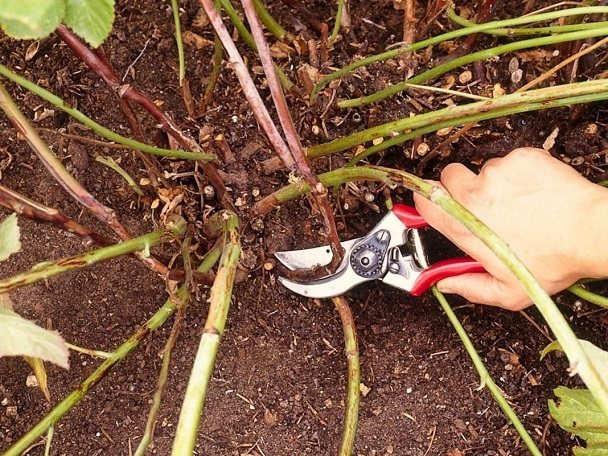

Caring for blackberries is a prerequisite for obtaining a decent harvest
Mandatory care steps:
- Removal from winter shelter. The beginning of spring, when the snow is just melting and the temperature is above zero - it's time to remove the shelter.
- Mulching and loosening. In the spring, the moisture content of the soil is high and it is up to the grower to maintain it. For this purpose, the soil around the shrub is covered with a layer of mulch. In addition, it is required to thoroughly loosen the soil, while simultaneously removing all weeds.
- Pruning. The time for pruning comes when the buds on the bush have not yet begun to swell. All frost-bitten, damaged and dry shoots, without exception, are subject to removal.
- Prevention of pests and diseases. Almost any variety of blackberry is characterized by high resistance to most diseases, insects also do not cause much harm to the plant. However, preventive spraying with Bordeaux liquid is strongly recommended at least once a year.
- Top dressing. Despite the fact that wild blackberries grow well even in poor soil conditions, garden varieties require mandatory feeding. The color, size and taste of the berries will largely depend on its quality.
Keep in mind! Garden blackberries react negatively to organic matter. Therefore, nitrogen-containing products are better suited for feeding. Fertilizers should not be overused either - an excess of nitrogen can provoke excessive foliage, slow down the formation of ovaries and, accordingly, berries.
Description of the blackberry variety Loch Ness (Loch Ness)
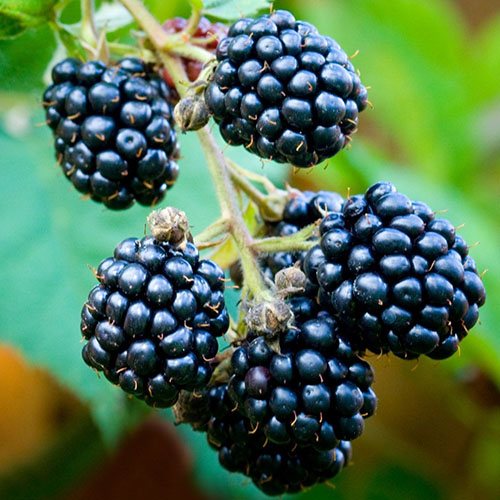

A bright aroma, excellent taste with a tart shade and a beautiful, even shape of berries weighing from 5 to 10 grams in weight are the characteristic features of the Loch Ness thornless blackberry, thanks to which the variety has been highly appreciated by the British Royal Society of Gardeners.
From each bush in a summer cottage, you can get about 15 kg of ripe berries, in conditions of intensive cultivation, the yield rises to 25-30 kg. At the same time, the fruits retain their appearance and taste for several days, which is important for the commercial use of plantings. According to the description, Loch Ness blackberries are ready for harvest in mid-August.
Blackberry Arapaho
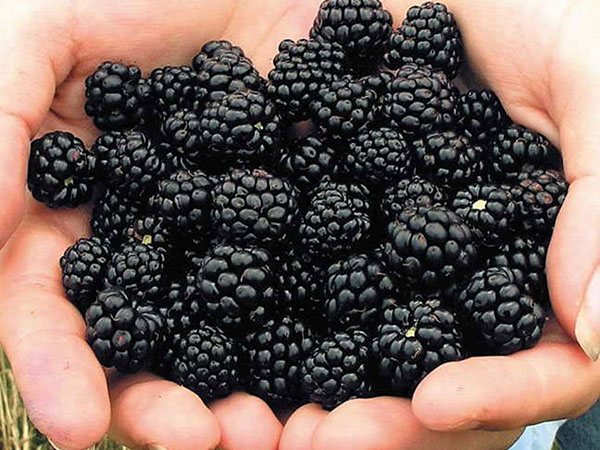

Blackberry varieties of American selection are among the most popular in the world. The Arapaho blackberry, obtained by Arkansas scientists in 1993, is part of an extensive line of plants named after American Indian tribes. Among the studless varieties, this variety is considered the earliest.
Berries weighing up to 7 grams ripen in the second half of July. Sweet fruits with a black shiny skin have a wide conical shape and a juicy pulp, the taste of which is practically not affected by small seeds.
Highly productive shrubs are not afraid of diseases and can withstand temperatures down to –24 ° C.
Blackberry Apache (Apache)
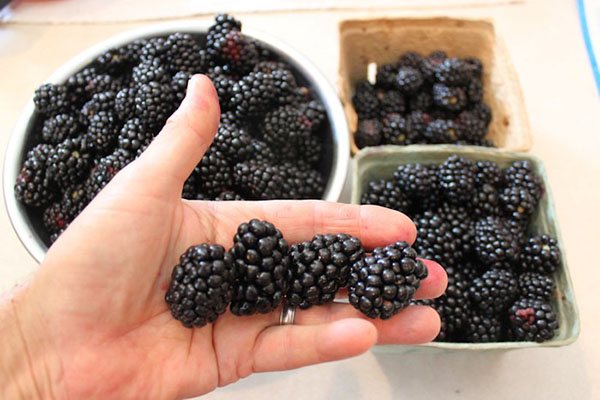

A hardy, frost-resistant Apache cultivar from the United States was first introduced to the horticultural community in 1999. Thornless blackberry with vigorous erect shoots gives large, up to 10 grams in weight, elongated berries of sweet taste.The fragrant fruits are equally suitable for fresh consumption and for freezing. The variety stands out for its excellent yield, comparable to the best commercial varieties, as well as high frost resistance.
Top 3 erect varieties (kumanika)
The most common upright varieties:
- Darrow Bush - grows upright and has shoots up to 2 m long. The crop appears 2-3 years after planting. It is quite resistant to cold weather, but in winter it needs to be wrapped.
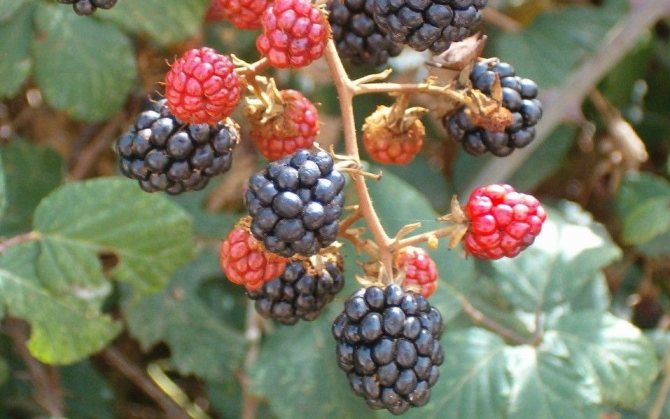

- Apache - this variety has become something of a non-standard variety of kumanik. The bush has straight shoots and powerful roots. The variety is capable of producing up to 5 kg of harvest.
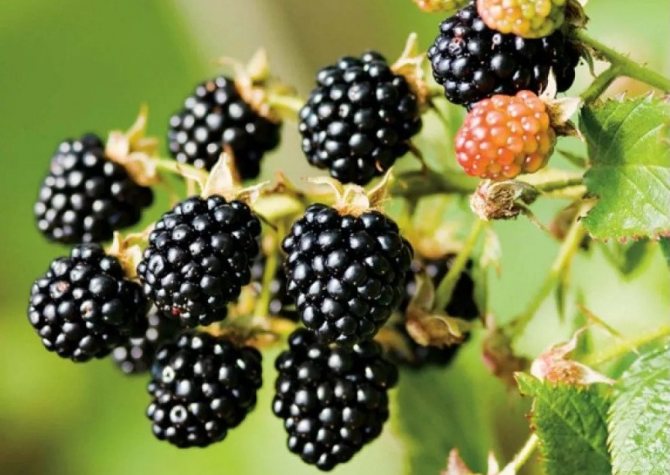

- Blackberry Apache has a major advantage - lack of thorns.
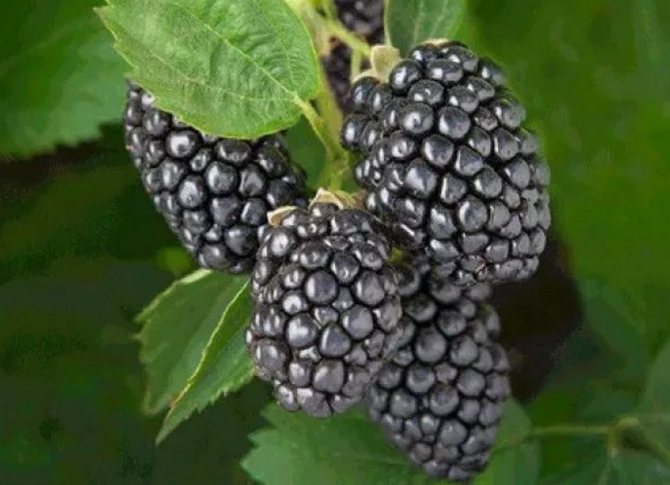

Blackberry Polar
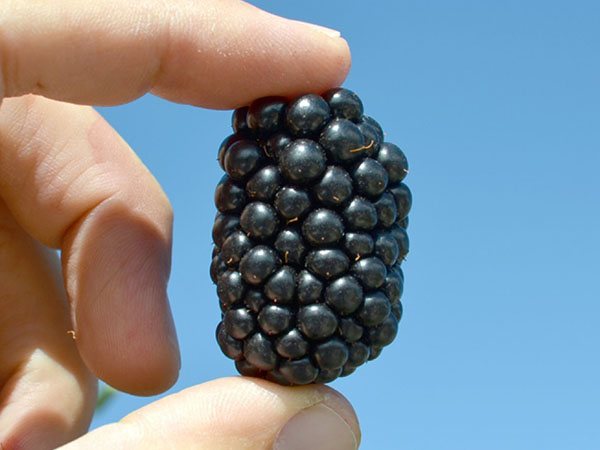

Polish breeders bred the Polar blackberry, which is interesting to Russian gardeners due to its high frost resistance and the possibility of growing bushes without additional shelter. Vigorous plants provide stable yields of large oval berries with shiny black skin and excellent sweet taste. The fruit can be used for home canning and eaten fresh.
Blackberry Kiowa
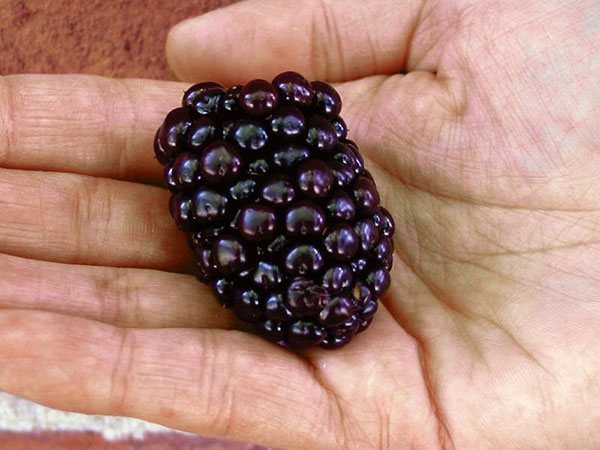

Another variety from Arkansas scientists will give gardeners incredibly large berries that can be called record-breaking. Blackberries of the Kiova variety bear fruits weighing up to 20 grams with medium-sized seeds, dense skin and excellent pulp taste. The berries ripen gradually, tolerate transportation well and do not shrink by the end of the season. The bushes themselves, formed by erect shoots up to 160 cm in height, can withstand temperatures down to -23 ° C.

